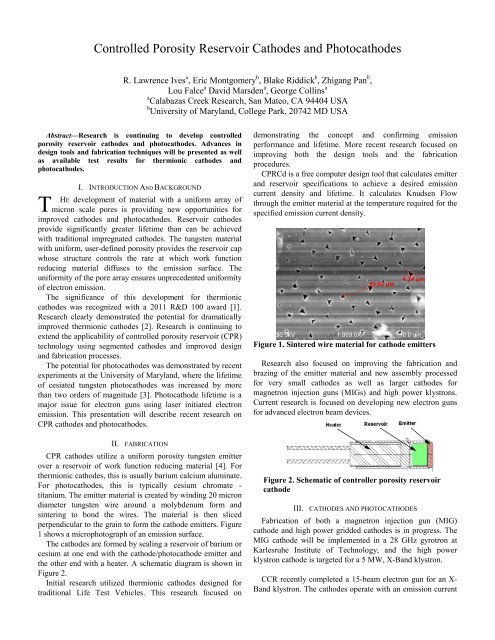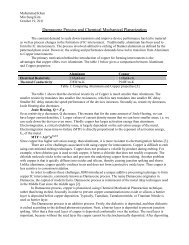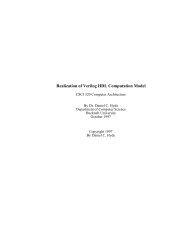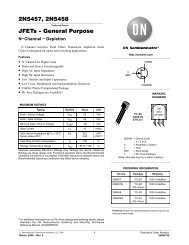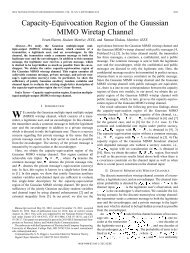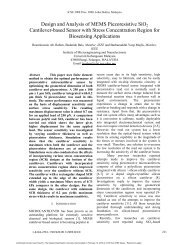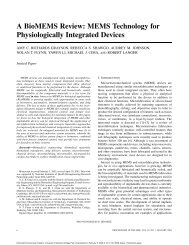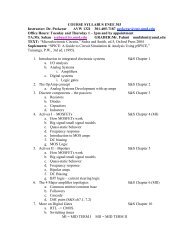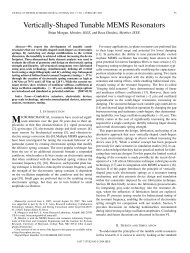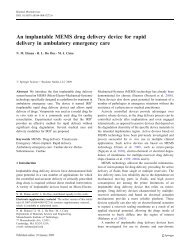MO P1-27.pdf - University of Maryland
MO P1-27.pdf - University of Maryland
MO P1-27.pdf - University of Maryland
You also want an ePaper? Increase the reach of your titles
YUMPU automatically turns print PDFs into web optimized ePapers that Google loves.
Controlled Porosity Reservoir Cathodes and Photocathodes<br />
R. Lawrence Ives a , Eric Montgomery b , Blake Riddick b , Zhigang Pan b ,<br />
Lou Falce a David Marsden a , George Collins a<br />
a Calabazas Creek Research, San Mateo, CA 94404 USA<br />
b <strong>University</strong> <strong>of</strong> <strong>Maryland</strong>, College Park, 20742 MD USA<br />
Abstract—Research is continuing to develop controlled<br />
porosity reservoir cathodes and photocathodes. Advances in<br />
design tools and fabrication techniques will be presented as well<br />
as available test results for thermionic cathodes and<br />
photocathodes.<br />
I. INTRODUCTION AND BACKGROUND<br />
HE development <strong>of</strong> material with a uniform array <strong>of</strong><br />
Tmicron scale pores is providing new opportunities for<br />
improved cathodes and photocathodes. Reservoir cathodes<br />
provide significantly greater lifetime than can be achieved<br />
with traditional impregnated cathodes. The tungsten material<br />
with uniform, user-defined porosity provides the reservoir cap<br />
whose structure controls the rate at which work function<br />
reducing material diffuses to the emission surface. The<br />
uniformity <strong>of</strong> the pore array ensures unprecedented uniformity<br />
<strong>of</strong> electron emission.<br />
The significance <strong>of</strong> this development for thermionic<br />
cathodes was recognized with a 2011 R&D 100 award [1].<br />
Research clearly demonstrated the potential for dramatically<br />
improved thermionic cathodes [2]. Research is continuing to<br />
extend the applicability <strong>of</strong> controlled porosity reservoir (CPR)<br />
technology using segmented cathodes and improved design<br />
and fabrication processes.<br />
The potential for photocathodes was demonstrated by recent<br />
experiments at the <strong>University</strong> <strong>of</strong> <strong>Maryland</strong>, where the lifetime<br />
<strong>of</strong> cesiated tungsten photocathodes was increased by more<br />
than two orders <strong>of</strong> magnitude [3]. Photocathode lifetime is a<br />
major issue for electron guns using laser initiated electron<br />
emission. This presentation will describe recent research on<br />
CPR cathodes and photocathodes.<br />
demonstrating the concept and confirming emission<br />
performance and lifetime. More recent research focused on<br />
improving both the design tools and the fabrication<br />
procedures.<br />
CPRCd is a free computer design tool that calculates emitter<br />
and reservoir specifications to achieve a desired emission<br />
current density and lifetime. It calculates Knudsen Flow<br />
through the emitter material at the temperature required for the<br />
specified emission current density.<br />
Figure 1. Sintered wire material for cathode emitters<br />
Research also focused on improving the fabrication and<br />
brazing <strong>of</strong> the emitter material and new assembly processed<br />
for very small cathodes as well as larger cathodes for<br />
magnetron injection guns (MIGs) and high power klystrons.<br />
Current research is focused on developing new electron guns<br />
for advanced electron beam devices.<br />
II. FABRICATION<br />
CPR cathodes utilize a uniform porosity tungsten emitter<br />
over a reservoir <strong>of</strong> work function reducing material [4]. For<br />
thermionic cathodes, this is usually barium calcium aluminate.<br />
For photocathodes, this is typically cesium chromate -<br />
titanium. The emitter material is created by winding 20 micron<br />
diameter tungsten wire around a molybdenum form and<br />
sintering to bond the wires. The material is then sliced<br />
perpendicular to the grain to form the cathode emitters. Figure<br />
1 shows a microphotograph <strong>of</strong> an emission surface.<br />
The cathodes are formed by sealing a reservoir <strong>of</strong> barium or<br />
cesium at one end with the cathode/photocathode emitter and<br />
the other end with a heater. A schematic diagram is shown in<br />
Figure 2.<br />
Initial research utilized thermionic cathodes designed for<br />
traditional Life Test Vehicles. This research focused on<br />
Figure 2. Schematic <strong>of</strong> controller porosity reservoir<br />
cathode<br />
III. CATHODES AND PHOTOCATHODES<br />
Fabrication <strong>of</strong> both a magnetron injection gun (MIG)<br />
cathode and high power gridded cathodes is in progress. The<br />
MIG cathode will be implemented in a 28 GHz gyrotron at<br />
Karlesruhe Institute <strong>of</strong> Technology, and the high power<br />
klystron cathode is targeted for a 5 MW, X-Band klystron.<br />
CCR recently completed a 15-beam electron gun for an X-<br />
Band klystron. The cathodes operate with an emission current
density <strong>of</strong> 31 A/cm 2 and eliminate requirements for beam<br />
compression. This dramatically simplified the gun design and<br />
improved the beam quality. The estimated lifetime exceeds<br />
90,000 hours.<br />
Figure 3. Photograph <strong>of</strong> 15-beam electron gun with CPR<br />
cathodes operating at 30 A/cm 2<br />
Figure 4 shows a solid model <strong>of</strong> the segmented MIG being<br />
built for KIT. The gun will be used to study the effects <strong>of</strong> nonuniform<br />
cathode emission on<br />
gyrotron performance. The<br />
current emitted from each<br />
segment will be externally<br />
controlled.<br />
Photocathode research is<br />
focused on extending the<br />
reservoir concept to<br />
photocathode materials with<br />
higher quantum efficiency.<br />
The Figure 6 shows current Figure 4. Solid model <strong>of</strong><br />
performance <strong>of</strong> photocathodes,<br />
including the recent advance<br />
for cesiated tungsten. CPR<br />
segmented MIG using CPR<br />
cathodes<br />
photocathodes use a modified version <strong>of</strong> the configuration<br />
shown in Figure 2. Because <strong>of</strong> the increased volatility <strong>of</strong><br />
cesium, the reservoir is capped by a section <strong>of</strong> sintered<br />
tungsten powder. This is followed by a mixing section and<br />
controlled porosity material for uniform cesium distribution<br />
over the surface. The unique feature <strong>of</strong> this configuration is<br />
that the cesium diffusion can be precisely controlled to match<br />
the surface evaporation rate.<br />
Current research is investigating evaporative and atomic<br />
layer deposition to deposit higher quantum efficiency<br />
materials onto the CPR tungsten material. Experiments will<br />
measure both the quantum efficiency <strong>of</strong> the photocathodes and<br />
the evaporation rate <strong>of</strong> cesium. This will allow estimation <strong>of</strong><br />
the lifetime. The goal is to increase the lifetime <strong>of</strong> high<br />
quantum efficiency materials by two orders <strong>of</strong> magnitude or<br />
more.<br />
Cathode and photocathode designs will be describes as well<br />
as available experimental results.<br />
Figure 6. Quantum efficiency and lifetime for common<br />
photocathode materials. Some cathodes have longer<br />
reported lifetimes under high vacuum, so the graph is<br />
normalized to a nanoTorr, assuming contaminationlimited<br />
lifetime scales linearly with chamber pressure.<br />
Figure 5. CPR configuration for cesiated photocathodes<br />
IV. SUMMARY<br />
CPR cathodes provide increased performance for both<br />
thermionic and photocathodes. This will lead to improved<br />
electron guns for electron beam devices<br />
V. ACKNOWLEDGEMENTS<br />
This research was supported by U.S. Department <strong>of</strong> Energy<br />
grants Nos. DE-FG02-04ER83918, DE-SC0006208, DE-<br />
SC0004570, and DE-SC0009583, and by the U.S. Army<br />
Research Office under contract W911NF-08C-0051 as part <strong>of</strong><br />
the DARPA HiFIVE program.<br />
REFERENCES<br />
[1] “Controlled porosity elevates performance, lifetime <strong>of</strong> cathodes,” R&D<br />
Magazine, Vol. 53, No. 5, September 2011.<br />
[2] R. Lawrence Ives, Senior Member, IEEE, Louis R. Falce, George<br />
Miram, George Collins, “Controlled Porosity Cathodes for High Current<br />
Density Applications,” IEEE Trans. Plasma Sci., Special Edition on<br />
High Power Microwave Sources, Vol. 38, No. 6, pp. 1345-1353, June<br />
2010.<br />
[3] Eric Montgomery, et al, “Enhanced Lifetime Hybrid-Diffuser Cesium<br />
Reservoir Photocathode,” Advanced Accelerator Concepts Workshop,<br />
Austin, TX June 2012.<br />
[4] R.L. Ives, L.R. Falce, S. Schwartzkopf, and R. Witherspoon, “Controlled<br />
Porosity Cathodes from Sintered Tungsten Wires, IEEE Trans. On<br />
Electron Devices, Vol. 52, No. 12, pp. 2800-2805, December 2005.


